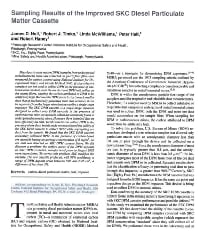Mining Publication: Sampling Results of the Improved SKC� Diesel Particulate Matter Cassette
Original creation date: January 2005
Authors: JD Noll, RJ Timko, LJ McWilliams, P Hall, R Haney
Diesel particulate matter (DPM) samples from underground metal/nonmetal mines are collected on quartz fiber filters and measured for carbon content using NIOSH Method 5040. If size-selective samplers are not used to collect DPM in the presence of carbonaceous ore dust, both the ore dust and DPM will collect on the quartz filters, causing the carbon attributed to DPM to be artificially high. Because the DPM particle size is much smaller than that of mechanically generated mine dust aerosols, it can be separated from the larger mine dust aerosol by a single-stage impactor. The SKC DPM cassette is a single-stage impactor designed to collect only DPM aerosols in the presence of carbonaceous mine ore aerosols, which are commonly found in underground nonmetal mines. However, there are limited data on how efficiently the SKC DPM cassette can collect DPM in the presence of ore dust. In this study, we investigated the ability of the SKC DPM cassette to collect DPM while segregating ore dust from the sample. We found that the SKC DPM cassette accurately collected DPM. In the presence of carbon-based ore aerosols having an average concentration of 8 milligrams per cubic meter, no ore dust was detected on SKC DPM cassette filters. We did discover a problem: the surface areas of the DPM deposits on SKC DPM cassettes, manufactured prior to August 2002, were inconsistent. To correct this problem, SKC modified the cassette. The new cassette produced, with 99% confidence, a range of DPM deposit areas between 8.05 and 8.28 cubic centimeters, a difference of less than 3%.

- DEEP Project on Evaluation of Diesel Particulate Filters at Inco's Stobie Mine
- Diesel Exhaust Aerosol, Review of Measurement Technology
- Differential Pressure as a Measure of Particulate Matter Emissions from Diesel Engines
- Effects of Diesel Exhaust Aftertreatment Devices on Concentrations and Size Distribution of Aerosols in Underground Mine Air
- The Effects of Passive Diesel Particulate Filters on Diesel Particulate Matter Concentrations in Two Underground Metal/Nonmetal Mines
- Instrumentation for Diesel Particulate Matter Emissions Research
- Mutagenicity of Diesel Exhaust Particles from an Engine with Differing Exhaust After Treatments
- Performance Evaluation of Diesel Particulate Filter Technology in the Underground Environment
- Real-Time DPM Ambient Monitoring in Underground Mines
- Role of Lubrication Oil in Particulate Emissions from a Hydrogen-Powered Internal Combustion Engine